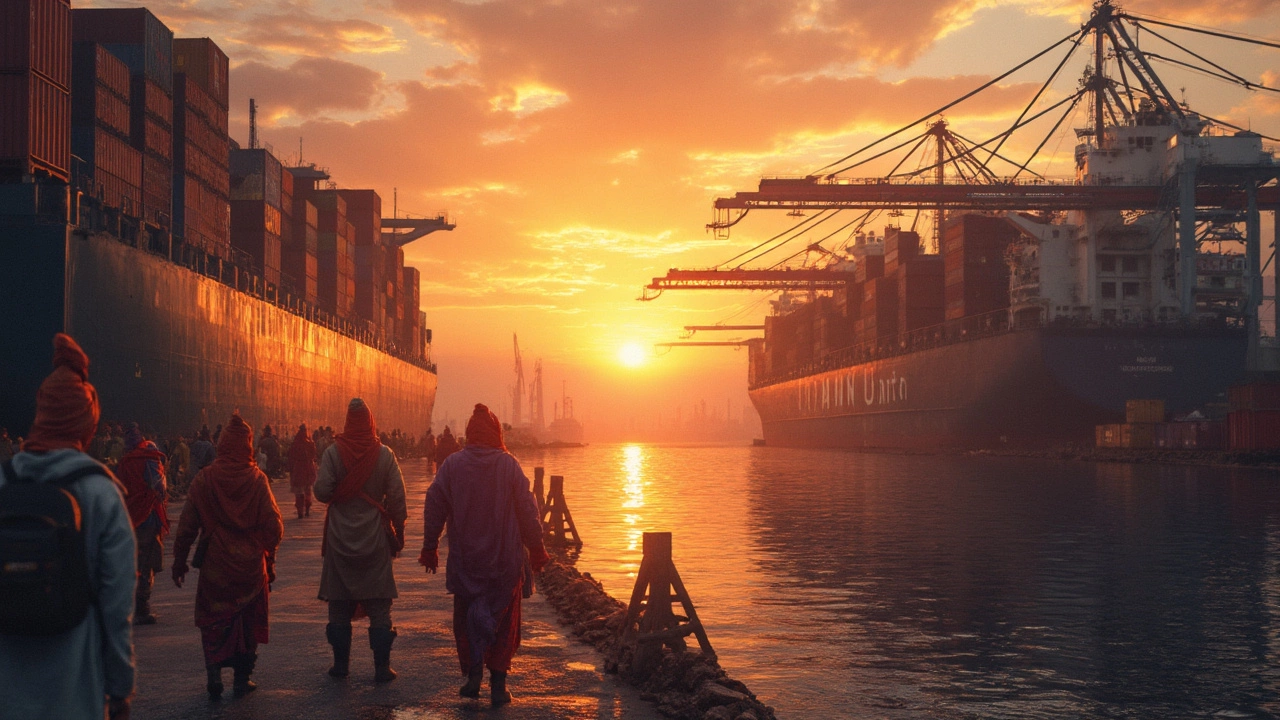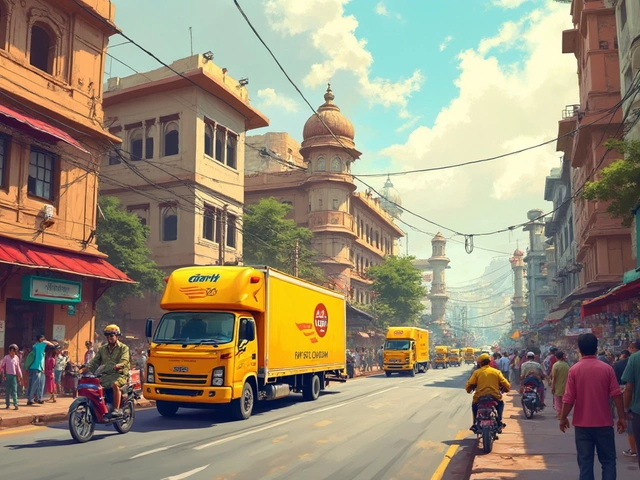Alright, so there's a ton of buzz around logistics and supply chains these days. Business battles are won or lost based on how well companies manage these two. But ever wondered if logistics is the heavyweight champ in this match-up?
Now, logistics is all about moving goods from point A to point B with efficiency, turning chaos into a smooth operation. Think of it like a well-oiled machine ensuring products land safely in your shopping basket. Meanwhile, supply chain management is a bit like the puppet master pulling the strings, covering everything from sourcing raw materials to delivering the final product.
You might be asking, 'Who wears the crown?' Well, it gets a bit tricky. Logistics is a key part of the supply chain, but it’s not the entire picture. They're more like two sides of the same coin, each essential to the game. Still, it's easy to see why people sometimes think logistics takes the cake—it’s the part everyone sees in action most of the time. Ready to break down the details? Let's get into it!
- Understanding Logistics
- What is the Supply Chain?
- Key Differences Between Logistics and Supply Chain
- The Role of Logistics in Business
- The Growth of Logistics Companies
- How Logistics and Supply Chain Work Together
Understanding Logistics
So, what exactly is logistics? It’s all about making sure goods travel from one point to another in the most efficient way possible. From your smartphone making its way from the assembly line to your front door, to the fresh fruits at your local grocery store, logistics makes it all happen.
Let's break it down a bit further. Logistics involves several key activities:
- Transportation: This is the part where goods are physically moved, whether by road, rail, sea, or air. Each method has its perks and choosing the right one depends on factors like cost, speed, and distance.
- Warehousing: Sometimes goods need a pit stop before reaching their final destination. Warehouses come into play here, storing products until they're good to go.
- Inventory Management: This is all about knowing what’s in stock and what needs to be ordered. It ensures businesses aren't caught off guard with too much or too little product.
- Order Fulfillment: It’s the grand finale where orders are packed and shipped to customers. Timing and accuracy matter big time here.
Why is logistics such a big deal? Well, it can make or break a business. Efficient logistics means lower costs, faster delivery times, and happier customers. On the flip side, messy logistics can lead to delays, extra expenses, and frustrated buyers.
Here’s a fun fact: According to 2024 data from the Council of Supply Chain Management Professionals, logistics costs in North America represented about 8% of the region’s GDP. That's a whole lot of money tied up in keeping everything moving smoothly!
In our interconnected world, logistics is more critical than ever. It’s the backbone that supports everything we do, from online shopping sprees to international trade. So next time a package arrives on your doorstep, take a moment to appreciate the complex dance of logistics that made it happen.
What is the Supply Chain?
The supply chain is like the hidden network that keeps everything running smoothly behind the scenes. It's all about getting products from the starting point, like the original source of materials, right to your door. Imagine it as a series of steps, each one a critical part of the journey that products take before landing on the shelves.
Supply chain management involves a couple of key stages to make sure everything flows seamlessly:
- Sourcing: It all begins here. Companies need to find suppliers who can provide quality raw materials or parts.
- Manufacturing: This is where the magic happens. Raw materials are turned into finished products.
- Transportation: Goods are now made, so it’s time to move them. This stage is where logistics steps in, ensuring products get to the right place at the right time.
- Warehousing: Sometimes products need a pit-stop in a warehouse before the final leap to stores or customers.
- Delivery: Finally, products are shipped to businesses or straight to your front door.
In today's fast-paced world, supply chains are often global, stretching across multiple countries and time zones. It's pretty cool but also super challenging. You’ve got to manage all these moving parts to keep costs down and efficiency up. Now and then, you'll see businesses using neat tech tools like AI and data analytics to predict demands or manage inventory better.
To put things in perspective, here's a quick snapshot: according to a logistics report by Armstrong & Associates, globally, the logistics part of supply chain management alone was worth over $5 trillion in 2023. That's a massive piece of the economic pie!
So, the supply chain is not just about moving stuff. It’s a carefully orchestrated series of events, making sure everything you buy gets to you easily and without a hitch.
Key Differences Between Logistics and Supply Chain
Alright, let's break it down. Even though people often use logistics and supply chain interchangeably, they’re not the same thing. Picture this: logistics is just one piece of the puzzle, while the supply chain is the entire picture.
Logistics is all about the transportation, storage, and distribution of goods. It's the nitty-gritty details of how products move from one place to another—like delivery trucks, warehouses, and shipping routes. It’s the sweat and grind ensuring packages get from the factory to your doorstep.
Now, supply chain management is more like the overseer. It takes care of everything logistics covers, but also deals with the big picture strategy. It includes stuff like sourcing raw materials, managing suppliers, and even handling customer returns. It’s all about optimizing the entire process from start to finish to improve efficiency and reduce costs.
To make this clearer, think of supply chain as an orchestra and logistics as the drummers. Both need to work in harmony, but their roles are pretty different. The orchestra gets its music (products) together and ensures all the instruments (steps in the process) are in sync. Meanwhile, the drummers keep the beat going strong and steady, like logistics keeping shipments flowing.
- Focus: Logistics is about detailed tasks; supply chain is about coordinating the big picture.
- Scope: Logistics deals with transport and storage; supply chain covers everything from production to delivery.
- Goal: Logistics ensures swift movement of goods; supply chain aims to streamline the whole flow of goods, information, and money.
This distinction is crucial for companies. Understanding these differences helps businesses fine-tune their approaches for maximum efficiency. Whether you're adjusting operations or strategizing growth, knowing where logistics ends and supply chain begins can be a game-changer.

The Role of Logistics in Business
Logistics is pretty much the backbone of any successful business today. Think of it like the unsung hero that keeps everything running smoothly. At its core, logistics ensures that products are in the right place at the right time, which is crucial for meeting customer demands and staying ahead of the competition.
In practical terms, logistics covers several key activities. It deals with transportation, warehousing, inventory management, and even packaging. Businesses rely heavily on these functions to enhance their operations and cut down costs. For example, optimizing routes can save companies a ton on fuel and time, boosting overall efficiency.
Here are some ways logistics makes a huge impact in business:
- Efficiency: By streamlining operations, logistics helps reduce delays and avoids bottlenecks in the supply chain.
- Customer Satisfaction: Businesses can deliver products swiftly and reliably, which is great for keeping customers happy and loyal.
- Cost Reduction: Effective logistics minimizes waste and lowers expenses related to storage and transportation.
- Risk Management: Logistics professionals anticipate potential disruptions and plan accordingly, minimizing the impact on business.
Did you know that, in 2023, the global logistics industry was valued at over $10 trillion? No wonder businesses are so invested in refining their logistics strategies. It's also predicted to continue growing as e-commerce and international trade expand, pushing logistics companies to innovate and adapt.
For businesses, having a robust logistics setup is not just a nice-to-have; it's essential for survival in today's fast-paced world. Whether it's a mom-and-pop store or a multinational giant, logistics ensures that every piece of the puzzle fits snugly together.
So, the next time you receive a perfectly timed delivery, remember there's a whole world of logistics working hard behind the scenes to make it happen.
The Growth of Logistics Companies
In recent years, logistics companies are popping up everywhere, and there’s a solid reason for that boom. They've become the backbone of many industries, ensuring that products make their way from manufacturers to consumers faster and more efficiently than ever before. But what’s driving this growth?
One big factor is e-commerce. Ever since we all fell in love with online shopping, the demand for quick and reliable delivery exploded. Companies like Amazon and Alibaba have set sky-high standards that other logistics companies strive to match. These companies are constantly evolving—frequently updating their technology, fleet, and processes to stay ahead.
Another reason these companies are expanding is the rise of globalization. More businesses than ever are trading globally, requiring a robust logistics network. This international demand pushes local logistics companies to scale up and cater services far beyond their borders.
Then there’s the tech side of things. Innovations like AI, drones, and autonomous vehicles are not just sci-fi fantasies anymore—they're becoming central to how logistics operations run. With real-time tracking and automated warehouses, logistics companies are finding ways to cut costs and increase speed.
Let’s not forget sustainability. Customers and governments are demanding greener methods, and companies that innovate in this direction gain a competitive edge. From electric trucks to optimized delivery routes, sustainable logistics practices are becoming mainstream.
If you glance at the numbers, you’ll see just how massive this industry is becoming. Check out some info from Industry Reports:
| Year | Market Size (in Billion USD) |
|---|---|
| 2020 | 320.1 |
| 2021 | 348.5 |
| 2022 | 377.6 |
| 2023 | 410.2 |
That upward trend isn't slowing down anytime soon. So, if you're thinking about getting into logistics or working with a logistics company, now might just be the perfect time.
How Logistics and Supply Chain Work Together
Alright, so let's break down how these two powerhouses—logistics and the supply chain—team up. Think of them as Batman and Robin, each with a vital role in their quest to get products to customers right on time.
Logistics is like the delivery engine of the supply chain. It's all about getting the right products to the right place, at the right time. It covers transportation, warehousing, inventory management, and even packaging. If it were a person, it’d be a hyper-organized project manager, making sure everything runs smooth as butter.
Now, the supply chain is the broader strategy. Imagine a chess player moving pieces with intent, each step carefully planned. From sourcing raw materials, calling the shots on production schedules, to final delivery, it's all in the supply chain’s playbook. It ensures there’s no missing link from A to Z.
Here's how they hook up in action:
- Planning and Forecasting: Supply chain gurus predict customer demand, and logistics ensures enough goods are ready to move.
- Sourcing: When sourcing materials, logistics figures out how to transport them cost-effectively.
- Production: While the supply chain coordinates production schedules, logistics handles the flow of materials between factories and warehouses.
- Delivery: Logistics ensures goods reach their final destination while the supply chain tracks overall progress to tweak and optimize.
These two — logistics and supply chain - aren't rivals. They’re more like partners in crime, working a seamless dance. When they’re in sync, products pop onto store shelves or your doorstep faster and with less fuss.
| Logistics Functions | Supply Chain Roles |
|---|---|
| Transportation | Sourcing |
| Warehousing | Production Planning |
| Inventory Management | Demand Forecasting |
| Order Fulfillment | Network Optimization |
Keeping these two well-aligned means spotting potential hiccups before they become full-blown problems, saving time, and chopping costs. So, it’s not so much about one being bigger or smaller than the other but keeping both working in harmony.





